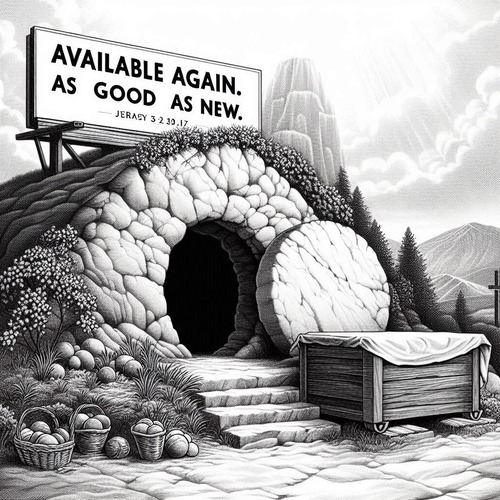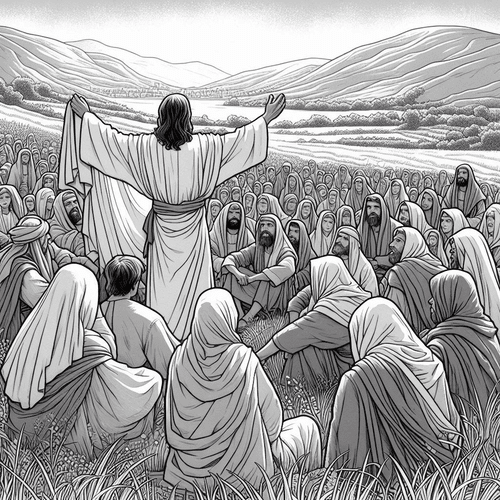Women at Jesus’ Tomb: Answers to Sceptics’ Toughest Objections
The women at Jesus' tomb have become unlikely lightning rods for criticism. Sceptics argue their testimony undermines rather than supports the resurrection account. Yet when we examine these objections carefully, we find that the women's presence actually provides some of the strongest evidence for the resurrection's historicity. Their testimony, far from weakening the Gospel accounts, demonstrates their remarkable reliability.
1. "WOMEN'S TESTIMONY WASN'T LEGALLY VALID—WHY WOULD ANYONE INVENT THIS DETAIL?"
Some sceptics flip the traditional argument, claiming it's suspiciously convenient that the story includes legally inadmissible witnesses.
But this objection misses the point entirely. The criterion of embarrassment actually supports the accounts' authenticity. No one fabricating a resurrection story would voluntarily include details that weakened their legal case. In first-century Palestine, women's testimony carried little weight in courts. If the Gospel writers were inventing this story, they'd have featured male witnesses exclusively.
Instead, they faithfully recorded what actually happened, regardless of cultural prejudices. This reflects God's consistent pattern throughout Scripture of using the humble and overlooked to accomplish His greatest purposes. The detail's inclusion despite its cultural liability demonstrates historical reliability, not fabrication.
2. "THE WOMEN WENT TO ANOINT A BODY THEY KNEW WAS SEALED IN THE TOMB—THIS SHOWS THE STORY IS FABRICATED"
This objection assumes the women knew about Pilate's official seal and guard before departing for the tomb.
However, the timeline suggests otherwise. Matthew 27:61 shows the women observing Jesus' burial on Friday evening, but the sealing and guard weren't arranged until Saturday (Matthew 27:62-66). The women likely made their plans before these additional security measures were implemented.
Moreover, their overwhelming grief may have clouded practical thinking. Jewish burial customs ran so deep they likely felt compelled to complete proper burial rites, regardless of obstacles. Mark 16:3 reveals they were discussing the stone problem while walking to the tomb, suggesting spontaneous, heartfelt action rather than calculated deception. Their genuine concern about moving the stone actually supports the account's authenticity.
3. "THE GOSPEL ACCOUNTS OF THE WOMEN'S TESTIMONY CONTRADICT EACH OTHER"
Sceptics point to differences in the names of the women at Jesus' tomb, who went, what they encountered, and what messages they received as proof of unreliability.
These variations actually mark authenticity rather than fabrication. Real eyewitness accounts naturally include different perspectives and emphases. The Gospel writers had access to different witnesses and sources, creating complementary rather than contradictory accounts.
The core facts remain remarkably consistent across all Gospels: women arrived early Sunday morning, found the tomb empty, encountered angelic beings, and were told Jesus had risen. Variations in peripheral details are exactly what we'd expect from genuine, independent testimonies. Perfect uniformity would actually suggest collusion and fabrication.
4. "WOMEN IN THAT CULTURE WOULDN'T HAVE BEEN OUT ALONE AT DAWN"
This objection claims cultural norms would have prevented unaccompanied women from traveling early in the morning.
However, exceptional circumstances call for exceptional actions. Their devotion to Jesus overcame normal social conventions. They didn't travel alone but in a group, providing mutual protection and maintaining propriety. Besides, the tomb was most likely close to Jerusalem, minimising risk and travel time.
Most importantly, the Sabbath restrictions had just ended at sunset Saturday, making Sunday dawn their first opportunity for burial preparations. Their willingness to venture out despite social norms demonstrates the depth of their love and commitment to Jesus—hardly the behaviour of conspirators or fabricators.
5. "THE WOMEN MISTOOK SOME MALE IN WHITE CLOTHING FOR AN ANGEL—NATURAL EXPLANATION"
Some suggest the angelic encounters can be explained as meetings with ordinary people wearing white garments—rather than with angels.
This explanation crumbles under examination. The Gospel accounts describe clearly supernatural phenomena: an earthquake, the massive stone rolling away, and Roman guards becoming "like dead men." These details point far beyond ordinary human encounters.
Multiple independent witnesses reported similar supernatural experiences, and the message content demonstrated divine knowledge—specific details about the resurrection and future plans that no human bystander would possess. The women's terror and the guards' dramatic reaction indicate something far more than a casual conversation with a stranger in white robes.
6. "GRIEF HALLUCINATIONS EXPLAIN THE EXPERIENCES OF THE WOMEN AT JESUS' TOMB"
The psychological explanation suggests emotional stress produced vivid but false experiences.
Hallucinations, however, are typically individual phenomena. Multiple women sharing identical visions stretches credibility. More importantly, the empty tomb remains a physical fact requiring explanation beyond psychological experiences.
The women's initial disbelief and fear contradict typical wish-fulfillment hallucinations. If their minds were creating comforting fantasies, we'd expect joy and immediate acceptance, not terror and scepticism. Later physical interactions with the risen Jesus—touching Him, watching Him eat—cannot be explained by hallucinations alone.
7. "THE WOMEN WENT TO THE WRONG TOMB—THEY PROBABLY SIMPLY GOT CONFUSED IN THEIR GRIEF"
This objection suggests the distraught women mistakenly went to an empty tomb and concluded Jesus had risen.
Joseph of Arimathea's tomb was distinctive—a new, rock-hewn sepulchre belonging to a wealthy council member. The women had carefully observed the burial location (Matthew 27:61, Mark 15:47), making confusion highly unlikely.
More decisively, Jerusalem's authorities could have easily corrected any mistake by producing Jesus' body from the correct tomb. Their failure to do so, despite having every motivation to disprove resurrection claims, speaks volumes. The disciples would have verified the location before risking their lives to proclaim the resurrection.
8. "THE DISCIPLES STOLE THE BODY, AND THE WOMEN WERE EITHER COMPLICIT OR DECEIVED"
This theory suggests the disciples stole the corpse, with the women either complicit or genuinely deceived. Sceptics claim this theory makes more sense than the resurrection.
The Roman guards, however, make this explanation implausible. These professional soldiers faced execution for failing their duty. They wouldn't have slept on watch or allowed theft. Besides, the disciples were scattered and demoralised after the crucifixion, lacking both motivation and courage for such a dangerous operation.
The genuine surprise and fear of the women at Jesus' tomb indicate they weren't part of any conspiracy. Most importantly, no one dies for a lie they know they fabricated, yet these same disciples later faced martyrdom proclaiming the resurrection.
9. "LATER LEGENDARY DEVELOPMENT—THE STORY GREW MORE MIRACULOUS OVER TIME"
Sceptics argue the resurrection account represents mythological additions to simpler historical events.
The timeline contradicts this theory. Paul's early creedal material in 1 Corinthians 15:3-8 already includes resurrection appearances, dating to within years of the crucifixion. The gap between events and written records is far too short for legendary development.
Archaeological and historical details in the Gospel accounts demonstrate access to early, reliable sources. The consistent core narrative across independent traditions suggests stable, early testimony rather than gradual mythological growth.
10. "WHY DID JESUS APPEAR ONLY TO GULLIBLE WOMEN, RATHER THAN TO HOSTILE WITNESSES TO PROVE HIS RESURRECTION?"
If Jesus truly rose, sceptics ask, why didn't He appear to Caiaphas, Pilate, or other critics to provide undeniable proof?
Jesus appeared to those prepared to receive and faithfully transmit His message. Hostile witnesses had already rejected overwhelming evidence during His earthly ministry. Additional proof wouldn't have changed hearts already hardened against truth.
This pattern reflects Jesus' teaching about divine revelation—it comes to those with receptive hearts rather than demanding skeptics (Matthew 11:25-27). The women and disciples became effective witnesses precisely because their encounters transformed them completely.
CONCLUSION: THE WOMEN AT JESUS' TOMB
The women's testimony, rather than weakening the resurrection account, actually strengthens it through historical authenticity and multiple independent attestation. Their presence as first witnesses demonstrates God's gracious choice to reveal history's greatest news to humble, devoted followers. Each sceptical objection, when carefully examined, reinforces rather than undermines the Gospel accounts' reliability and the glorious reality of Christ's resurrection.
THE WOMEN AT JESUS' TOMB: OUR RELATED POSTS
Editor's Pick

GPS Without Eyes: How Ants Silently Shout Intelligent Design
Picture a leafcutter ant navigating the rainforest floor in pitch darkness, carrying a leaf fragment 50 times its body weight. [...]

Born Broken: Why Must We Affirm Original Sin?
Imagine a world where we’re born neutral—free to choose good, and without a bias toward evil. Sounds appealing… until we [...]

Does God Truly Care About My Everyday Choices?
OWe believe God created the universe. We believe He orchestrated the exodus from Egypt and raised Jesus from the dead. [...]
SUPPORT US:
Feel the Holy Spirit's gentle nudge to partner with us?
Donate Online:
Account Name: TRUTHS TO DIE FOR FOUNDATION
Account Number: 10243565459
Bank IFSC: IDFB0043391
Bank Name: IDFC FIRST BANK






